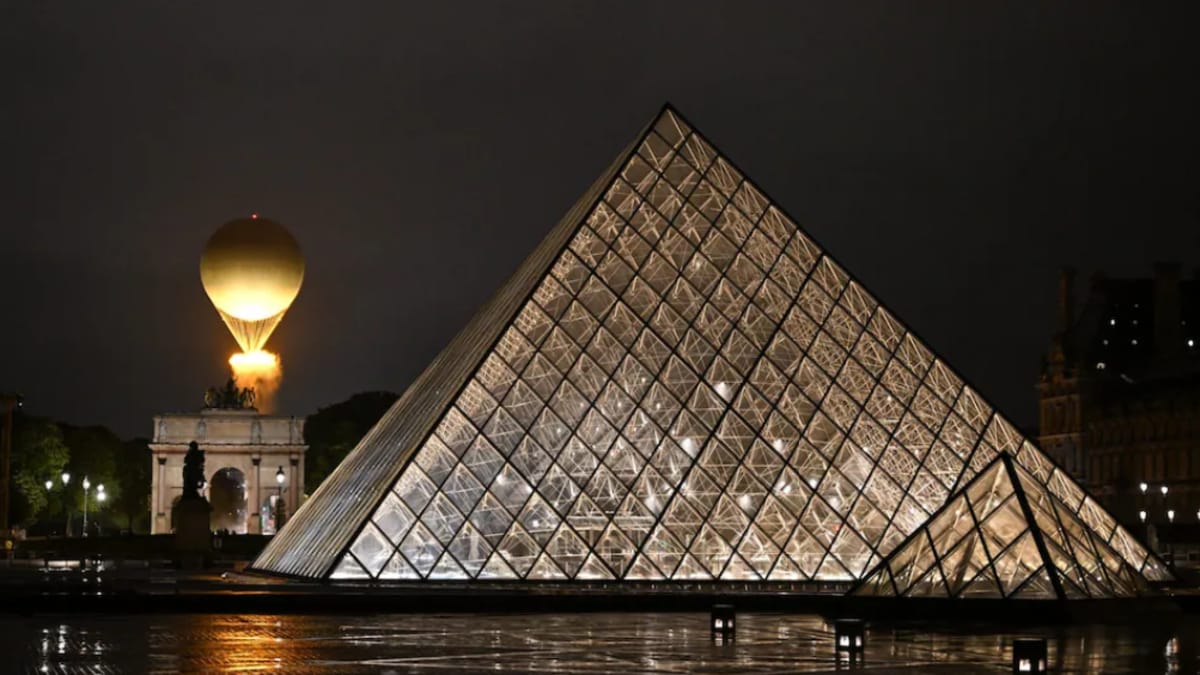- At the opening ceremony of the Paris Olympics last Friday evening, the main cauldron, lifted by a balloon, slowly ascended in the Tuileries Garden. The warm glow of the "flame" illuminated the surrounding Louvre Pyramid and the Obelisk of the Place de la Concorde.
The Paris 2024 team showcased an unprecedented cauldron design, demonstrating France's deeply ingrained romanticism to the world.
However, behind this unique cauldron lies an even greater innovation - it is the first main cauldron in Olympic history without a real flame. The "flame" seen by the audience is actually a visual effect created by a combination of light flow and water mist.
"This is a brand-new initiative. We aim to create the most eco-friendly and green Olympics, so we abandoned the traditional use of fossil fuels in favor of electricity, forming the main cauldron's 'electric flame' for these Olympics," said Tony Estanguet, president of the Paris 2024 organizing committee.
The design of the main cauldron, like the torch, was crafted by French designer Mathieu Lehanneur. The cauldron maintains the same design style as the torch, with a sleek and metallic exterior. Hidden in the center of this 7-meter diameter cauldron are 40 LED spotlights capable of outputting 4 million lumens of light, along with 200 high-pressure mist nozzles. The controlled spray of water mist and powerful light flow create the visual effect of a warm-colored flame.
Estanguet explained that to achieve the perfect ignition effect, when the final torchbearers - France's Olympic judo champion Teddy Riner and athletics champion Marie-José Pérec - "lit" the main cauldron on the night of the opening ceremony, backstage staff simultaneously activated the LED lights and mist nozzles through controlled switches, instantly completing the transformation of the two different "flames".
For power supply, the Paris organizing committee's partner, Electricité de France (EDF), provided a solution. Special cables were used to transmit power and high-pressure water flow to the main cauldron. The total height of the cauldron and balloon installation is approximately 30 meters. According to the plan, from 11am to 7pm daily, staff will control the cauldron with cables, bringing it closer to the ground for visitors to view up close.
At night, the cauldron will be raised 60 meters above the ground, recreating the romantic atmosphere of the opening ceremony. When the balloon is in the air, the water mist consumes about 3 cubic meters of water per hour; when closer to the ground, the consumption is 2 cubic meters per hour.
"Seeing the cauldron rise, I was holding back tears. When I first proposed raising the cauldron into the air, everyone thought it was a crazy idea, but we did it in the end," said Lehanneur.
Speaking to Xinhua, Lehanneur expressed hope that Chinese audiences would appreciate this design.
The ballon used to carry the cauldron is part of the long history of flight. It was in Paris, in 1783, that the very first flight in human history took place. The scientist Pilatre de Rozier and the Marquis d'Arlandes took to the skies based on the research of the Montgolfier brothers.
Still in France, and while the Montgolfiers were developing their hot air balloon in a rather empirical way, the physicist Jacques Charles invented the gas balloon, filled with hydrogen. A more powerful, safer and more sophisticated balloon that took off a few days after Pilatre de Rozier's flight, and took off from the Tuileries Gardens, from the same location, in front of 400,000 stunned people.
A hundred years after the first hot air balloon exploits, in 1878, it was again at the Tuileries that a French engineer, Henri Giffard, invented the captive balloon, composed of a gas balloon and a steam winch, which would enjoy resounding success.
Although Chinese internet descriptions of the Paris Olympic cauldron use the term "hot air balloon," it is technically a captive balloon.

